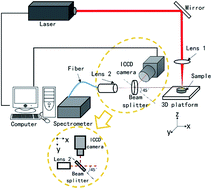当前位置:
X-MOL 学术
›
J. Anal. At. Spectrom.
›
论文详情
Our official English website, www.x-mol.net, welcomes your feedback! (Note: you will need to create a separate account there.)
An intensity correction method combined with plasma position information for laser-induced breakdown spectroscopy
Journal of Analytical Atomic Spectrometry ( IF 3.4 ) Pub Date : 2017-10-13 00:00:00 , DOI: 10.1039/c7ja00291b P. Zhang 1, 2, 3, 4, 5 , L. X. Sun 1, 2, 3, 4, 6 , H. B. Yu 1, 2, 3, 4, 6 , P. Zeng 1, 2, 3, 4, 6 , L. F. Qi 1, 2, 3, 4, 6 , Y. Xin 1, 2, 3, 4, 6
Journal of Analytical Atomic Spectrometry ( IF 3.4 ) Pub Date : 2017-10-13 00:00:00 , DOI: 10.1039/c7ja00291b P. Zhang 1, 2, 3, 4, 5 , L. X. Sun 1, 2, 3, 4, 6 , H. B. Yu 1, 2, 3, 4, 6 , P. Zeng 1, 2, 3, 4, 6 , L. F. Qi 1, 2, 3, 4, 6 , Y. Xin 1, 2, 3, 4, 6
Affiliation

|
The uncertainty of collected spectral data is one of the most important issues for the application of laser-induced breakdown spectroscopy (LIBS) quantitative analysis. The fluctuation of the target surface simultaneously affects both the focus depth of the laser beam and the relative collection position, either of which may lead to severe fluctuation of the spectral signal. Thus, in this study, for detecting and reducing the fluctuation, an imaging system was deployed to monitor the plasma, and a mathematical model was also built based on both spectral signal and positional information. An ICCD camera was used to record the image of the plasma so as to detect the plasma and acquire positional information. Furthermore, the relationship between plasma position and specific spectral line intensity was obtained by the fitting function. Five aluminium alloy samples were employed to validate the reliability of the proposed method. As a result, the average RSDs of the samples (with a position fluctuation range of about 2 mm) in different spectral lines (Si 288.15 nm, Fe 273.95 nm, Cu 324.75 nm, Mn 259.37 nm and Mg 280.27 nm) were reduced from 34.57%, 38.86%, 31.05%, 39.74%, and 36.91% (without normalization) to 4.63%, 6.84%, 5.64%, 7.64%, and 4.83% (with the combination method presented in this paper), respectively; the determination coefficients (R2) reached 0.996, 0.999, 0.989, 0.999, and 0.9999, respectively. These results prove that the proposed method can both improve measurement reliability and guarantee measurement accuracy.
中文翻译:

结合等离子体位置信息的强度校正方法用于激光诱导击穿光谱
收集光谱数据的不确定性是应用激光诱导击穿光谱(LIBS)定量分析的最重要问题之一。目标表面的波动同时影响激光束的聚焦深度和相对的采集位置,这两者都可能导致光谱信号的严重波动。因此,在这项研究中,为了检测和减少波动,部署了成像系统来监视等离子体,并且还基于光谱信号和位置信息建立了数学模型。使用ICCD相机记录等离子体的图像,以便检测等离子体并获取位置信息。此外,通过拟合函数获得了等离子体位置与特定光谱线强度之间的关系。五个铝合金样品被用来验证该方法的可靠性。结果,样品在不同光谱线(Si 288.15 nm,Fe 273.95 nm,Cu 324.75 nm,Mn 259.37 nm和Mg 280.27 nm)中的平均RSDs(位置波动范围约为2 mm)从34.57降低。 %,38.86%,31.05%,39.74%和36.91%(未归一化)分别为4.63%,6.84%,5.64%,7.64%和4.83%(采用本文所述的组合方法); 确定系数(91%(不进行归一化),分别为4.63%,6.84%,5.64%,7.64%和4.83%(采用本文所述的组合方法);确定系数(91%(不进行归一化),分别为4.63%,6.84%,5.64%,7.64%和4.83%(采用本文所述的组合方法);确定系数(R 2)分别达到0.996、0.999、0.999、0.999和0.9999。这些结果证明了该方法既可以提高测量的可靠性,又可以保证测量的准确性。
更新日期:2017-10-27
中文翻译:

结合等离子体位置信息的强度校正方法用于激光诱导击穿光谱
收集光谱数据的不确定性是应用激光诱导击穿光谱(LIBS)定量分析的最重要问题之一。目标表面的波动同时影响激光束的聚焦深度和相对的采集位置,这两者都可能导致光谱信号的严重波动。因此,在这项研究中,为了检测和减少波动,部署了成像系统来监视等离子体,并且还基于光谱信号和位置信息建立了数学模型。使用ICCD相机记录等离子体的图像,以便检测等离子体并获取位置信息。此外,通过拟合函数获得了等离子体位置与特定光谱线强度之间的关系。五个铝合金样品被用来验证该方法的可靠性。结果,样品在不同光谱线(Si 288.15 nm,Fe 273.95 nm,Cu 324.75 nm,Mn 259.37 nm和Mg 280.27 nm)中的平均RSDs(位置波动范围约为2 mm)从34.57降低。 %,38.86%,31.05%,39.74%和36.91%(未归一化)分别为4.63%,6.84%,5.64%,7.64%和4.83%(采用本文所述的组合方法); 确定系数(91%(不进行归一化),分别为4.63%,6.84%,5.64%,7.64%和4.83%(采用本文所述的组合方法);确定系数(91%(不进行归一化),分别为4.63%,6.84%,5.64%,7.64%和4.83%(采用本文所述的组合方法);确定系数(R 2)分别达到0.996、0.999、0.999、0.999和0.9999。这些结果证明了该方法既可以提高测量的可靠性,又可以保证测量的准确性。


























 京公网安备 11010802027423号
京公网安备 11010802027423号